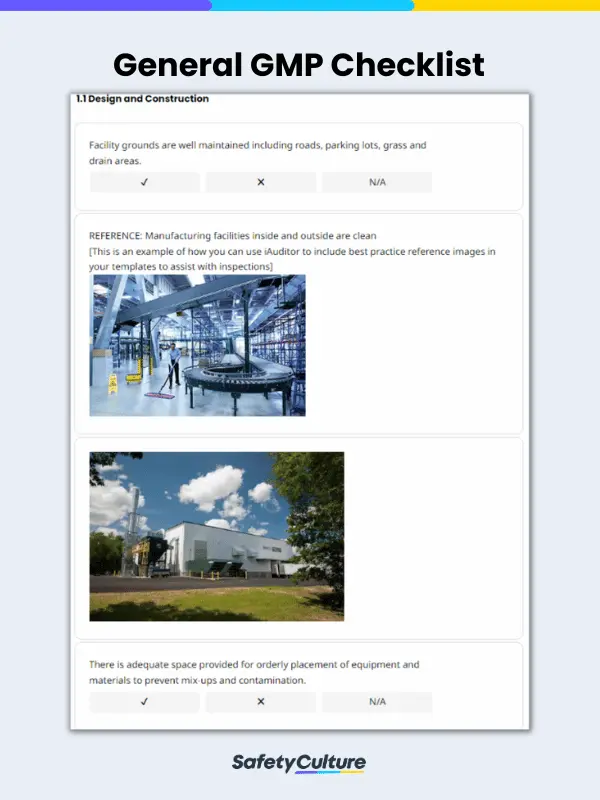What is a GMP Audit Checklist?
A Good Manufacturing Practices (GMP) audit checklist is a tool used by manufacturers to ensure that food, pharmaceutical, medical, and cosmetic products are of consistent quality and in compliance with manufacturing standards. A GMP audit should cover all the necessary procedures to collect valuable practices information such as supplier procedures, sanitary operations, premises, warehousing, and controls. Performing regular GMP compliance audits protects a business from product safety issues, product recalls, and legal and regulatory problems.
What is a GMP Audit?
A GMP audit is a third-party audit conducted to assess if an organization is compliant with GMP regulations and industry standards on acceptable good manufacturing practices. It helps identify areas for improvement on GMP compliance and also provides guidance on how to become compliant.
GMP Self Inspection Checklist
Aside from general GMP checklists that businesses can use, employees are empowered to further ensure safety and hygiene in food manufacturing and across various industries using self-inspection checklists. This GMP Self Inspection Checklist is ideal for staff and employees that need to observe good manufacturing practices starting from their individual work. It also allows lone workers to systematically follow procedures and protocols even without direct supervision from higher-ups.
Who is Responsible for GMP Compliance?
The ones primarily responsible for GMP compliance are those in the quality team, this includes executives such as chiefs of quality control, directors of quality, and facilities managers, or those directly involved in quality-specific jobs such as quality control inspectors and quality assurance managers. They are in charge of ensuring that GMP requirements, standards, and protocols are followed.
GMP audits are accomplished by certified auditors and regulated by agencies such as Food and Drug Administration (FDA), however, facilities are encouraged to do their own audits.
10 Principles of GMP
The basic principles of good manufacturing practices help ensure product quality is consistent and safe to use. Incorporating these will determine the scope and standards needed to pass GMP Auditing. The 10 principles of GMP are the following:
- Create Standard Operating Procedures (SOP) for processes and design specifications for facilities and equipment
- Follow the SOP and specifications
- Validate the SOP and specifications
- Document everything
- Monitor the facilities and equipment
- Employ competent and qualified personnel
- Protect products against contamination
- Control components and processes that are related to the product
- Ensure quality in operations, manufacturing, logistics, and distribution
- Perform periodic audits with certified auditors
9 Necessary Factors for GMP Audit Certification
The FDA provides guidelines for a proper GMP inspection checklist. The Inspection Operations Manual provides specific guidelines per industry and type of goods manufactured. Products are restricted from entering the market if they are deemed to be contaminated or mislabeled. Strict compliance to good manufacturing practices prevents products from adulteration and misbranding. The following are factors that will be inspected during a GMP audit:
- Building and facilities – This includes flooring, furnitures, fixtures, and water systems. The building itself should have the correct size and design according to their facility. The interior such as floors, walls, and ceilings should be smooth and easily cleaned. Fixtures, ducts, and pipes should be sealed and don’t create condensation. Also, there should be enough lighting and ventilation for the workers and the production floor. Facilities and equipment that involves water should be enough for cleaning purposes.
- Equipment – suitable equipment should be used for its intended purpose. These should be maintained and cleaned regularly to avoid contamination of the product. Additionally, smaller equipment should have proper storage when not in use.
- Personnel – Workers should be well trained and educated on the manufacturing process of the products. Personnel that directly handle the equipment and products have to wear clean garments and uniforms which includes hair net and gloves. There should be designated areas for eating, drinking, and smoking, away from production.
- Raw materials – These should be stored and labeled appropriately. To avoid adulteration, materials should be sampled and tested. This helps determine if the material meets the specified standards.
- Production – There should be written instructions on formulations, processes, and other operations and control procedures.
- Laboratory controls – This corresponds to the inspection of raw materials, samples, and water supply. Laboratory controls determine if the resources are usable and in good condition.
- Records – This gives importance to proper documentation of every process, laboratory controls, materials, and products. Products that are manufactured by batches should have records on 4 categories:
- Used material’s kind, lot, and quantity.
- Processing, handling, transferring, holding, and filling.
- Sampling, controlling, adjusting, and reworking.
- Code marks of batches and finished products.
- Labeling – Aside from product name, the contents and composition needs to be clearly stated on the label. Most products need to state a warning that is required for it. The warning depends on location, type of product, and consumption.
- Complaints – The FDA will check the consumer complaint file. Factors to consider are the type and severity of the injury and which specific product caused it. Another information needed is the medical treatment given to the consumer and the name of the physician (if there’s any). Lastly, the name/s, location/s, or governing bodies the complaint information was given to.
How to Prepare for the Audit
Review the scope of the GMP audit
Review in advance the coverage of the audit, such as the locations and processes to be audited, as well as the timeframe needed by the auditors.
Communicate the audit plan to your team
Make sure that the plan is communicated to all site personnel, especially those whose areas will be audited. Clearly list the areas / systems / products to be audited and list
specific dates for each of the audits.
Know which standards are covered
Identify which standards will be covered in the GMP audit. Audit standards may include:
- Applicable policies
- Laws and regulations
- Procedures
- Management system requirement; or
- Contractual agreement with suppliers
Be sure that you are precisely familiar with the standards and any policies regarding their explanation and application.
Know your documents and prepare them ahead of time
Prior to the audit, ensure that your team has reviewed any documentation that an auditor is likely to request. Make sure that all documentation is accessible and that all circulated documents are ‘controlled copies’ and up-to-date.
The documentation may include:
- Relevant management system documents and records
- Applicable standards
- Site master file
- Training records
- SOP’s
- Previous audit reports
Typically, the auditor will review the following documents before arriving on your site: Site Master File (if the auditor is new to your site) Validation Master Plan previous audit findings and your responses complaints and adverse events.
Define tour routes
It will be helpful to establish routes through the facility to have an efficient GMP audit. Ensure that your auditees are assigned in areas and are capable of answering auditors’ questions.



